俁亅俀丂Corynoneura group丂丂乮丂with long antenna乯丂丂丂丂丂丂丂丂丂丂丂丂丂丂丂丂丂to Orthocladinae group
丂丂丂丂丂丂丂丂丂丂丂丂丂丂丂丂丂丂丂丂丂丂丂丂丂丂
Corynoneura 丂丂Thienemanniella 丂丂Rheosmittia
| 丂 |
mentum |
antenna |
characteristic |
| Corynoneura |
3 median teeth the same size,
or central tooth small or absent.
5 pairs of lateral teeth. |
1.0乣1.5times of head capsule.. 4 segments.
segment 2 and 3 dark brown. |
Variably developed seta (usually plumose)
arising from ventral basal side of posterior
parapod, |
| Thienemanniella |
3 median teeth the same size,
or central tooth small or absent.
5 pairs of lateral teeth. |
0.4乣0.8 times of head capsule. 5 segments.
segment 3 long or short.
|
Strong, simple seta arising from ventral basal
side of posteriorparapod |
| Rheosmittia |
trapezoid, with 8乣10丂teeth in upper side,
and 4乣5pairs of rateral teeth in oblique
sides |
0.5乣1.2 times of head capsule. 5 segments.
segment 2 as long as basal segment. |
Abdominal segment violet spotted
premandible with up to 10 teeth . |
Corynoneura
Corynoneura larvae distributed widely in the country , in the stream and
pool . 10 or more species occurred in Japan.丅
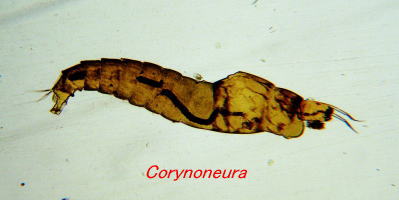 |
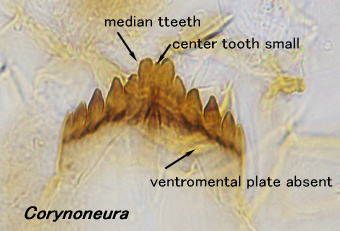 |
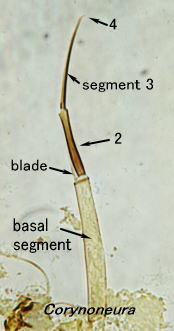 |
Small size larvae , less than 3 mm. Antenna with 4 segments , 1.0乣1.5 times
of head capsule.
|
3 median teeth the same size, or central tooth small or absent.
5 pairs of lateral teeth. Ventromental plate absent. |
Antenna with 4 segments.
Antennal ratio 0.7乣乣1.0.
Segment 4 very short. Blade less than 1/2 of segment 2.
Lauterborn's organ small. |
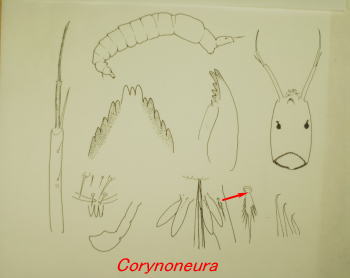 |
丒Mandible: Apical tooth the same size or smaller than the 1 st. inner
teeth. Inner teeth 4.
丒S嘥weak and simple. 俽嘦slightly strong and long.
丒Pecten epipharyngis 3 long simple scales , with two outer chaetulae laterals
strongly modified (resembling 5 spines)
丒Premandible simple spatula_shape.( with many minute teeth ?) |
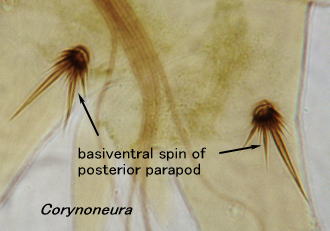 |
| Seta of ventral basal side of posterior parapod, |
丂丂丂丂丂丂丂丂丂丂丂丂丂丂丂丂丂丂丂丂丂丂丂丂丂丂丂丂丂丂丂丂丂丂丂丂丂丂丂丂丂丂丂丂丂丂丂丂丂丂丂丂丂丂丂丂丂丂丂丂丂丂丂丂丂丂丂丂丂丂丂
return to top of this page
Thienemanniella
Thienemanniella larvae are found widely from slow strem to fast , and rich in species
20 or more recognized in the country.
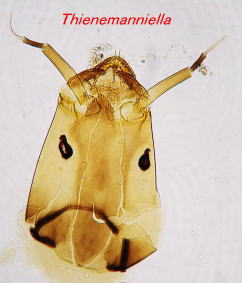 |
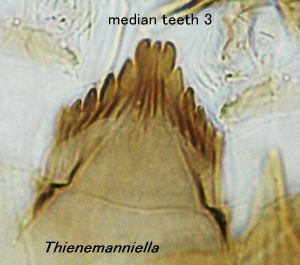 |
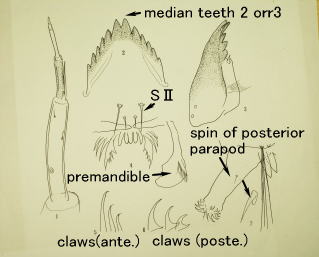 |
| Small larvae, up to 2 mm. Antenna not longer than head capsule. |
Median teeth 2 or 3, center tooth large ,small or absent. 5 pairs of lateral
teeth. Ventromental plate poorly developed. |
丒Mandible: Apical tooth subequal to first of 4 inner teeth.
丒俽嘥and 俽嘦simple and weak. Pecten epipharyngis 3乣5
triangular scales. Premandible with 1 apical tooth and long brush
丒A strong , simple seta arises from ventral basal half of posterior parapod. Anal setae 4. |
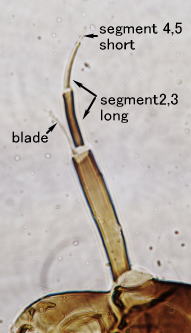 |
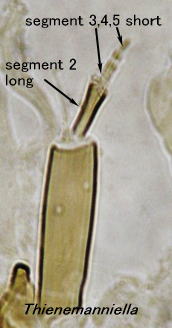 |
|
We can see 2 types about antenna of Thienemanniella .
1. Segment 2 and 3 subequal in length , segment 4and 5 short. ( upper fig.
left)
2. Segment 2 long, segment 3,4 and 5 short ( upper fig. right)
Ring organ on basal part and and 2 weak setae on upper part of basal segment. |
|
return to top of this page
Rheosmittia
Small size larvae, about 俁mm. Several species of Rheosmittia larvae occurred widely in the country, but the population not many.
Because the living body is spotted design of bluish violet like a lower
photograph, we can judge at a glance it with Rheosmittia larva.
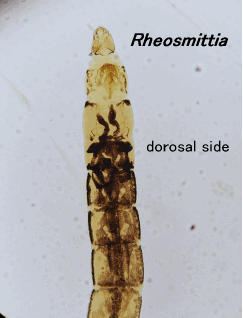 |
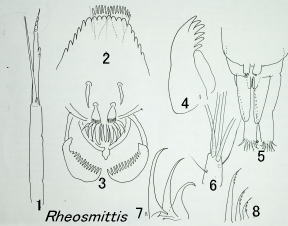 |
1 Antenna: 俆 segments , segment 2 as long as first. One style apical
1/3 of segment 2 . Segment 3乣5 short. Antannal ratio
0.7乣1.5 .
2 Mentum :trapezoid, with 8乣10丂teeth in upper side, and
4乣5pairs of rateral teeth in oblique
sides丂
係丂Mandible: With 5 inner teeth , someone with 7 teeth.
俁丂俽嘥plumose
丂丂俽嘦strong, simple丂
丂丂Pecten epipharyngis 3 simple , long scales.忋
丂丂Premandible :with up to 10 teeth.
俆丂Anal tubules long cnical.
俇丂Procercus with 4 anal setae.
俈丂Claws of posterior parapod
俉丂Claws of anterior parapod
|
| Body segment 1乣3 pale yellow, dorosal side of 4乣12 segments spotted design of bluish violet . |
丂 |
丂 |
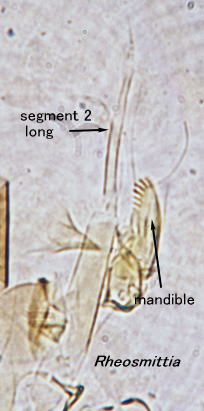 |
丂 |
丂
|
Antenna 0.9乣1.2 times of head capsule.
Inner teeth of mandible long. |
|
|
return to top of this page












